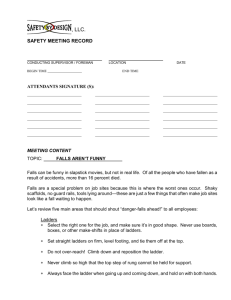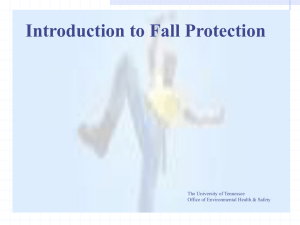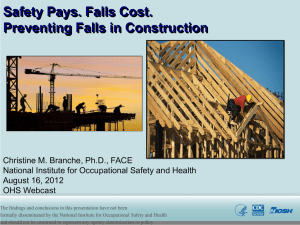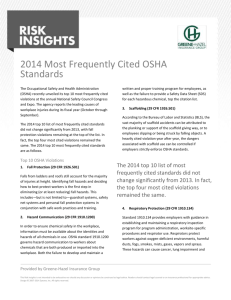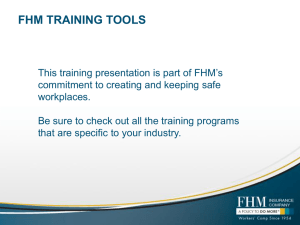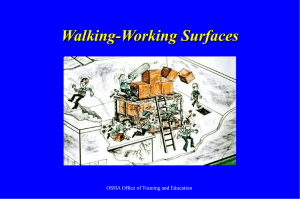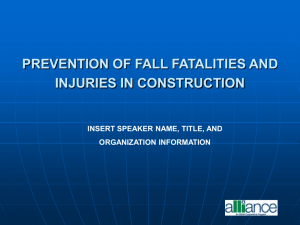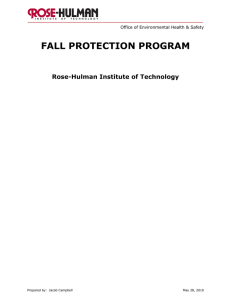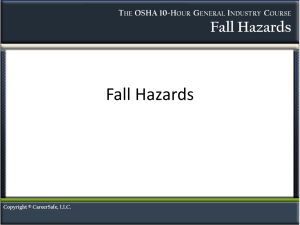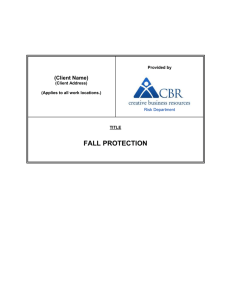FALL PROTECTION
advertisement
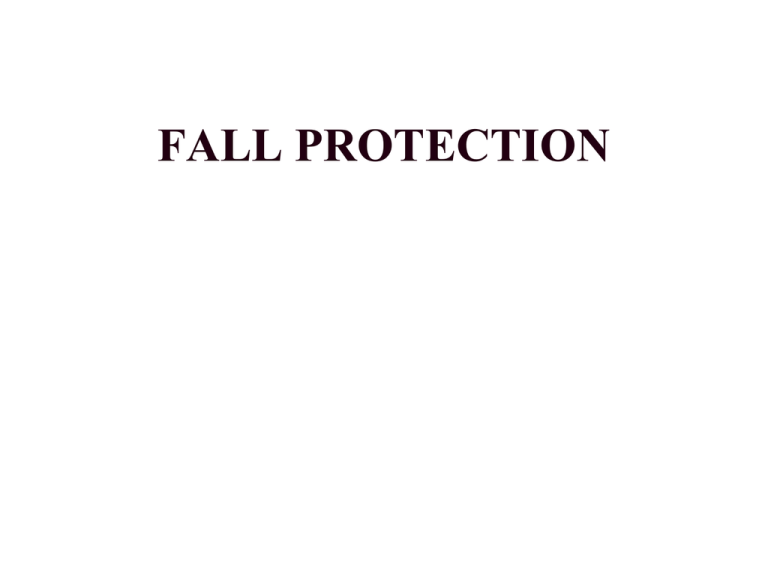
FALL PROTECTION FALL PROTECTION • WHY? – BECAUSE: • Falls accounted for 10% of fatal work injuries in 1994 & 1995. • Serious hazards can be present while above ground. – Examples: Slips, trips, falling objects, etc. REGULATIONS • Occupational Safety And Health Administration – General Industry • • • • • OSHA 1910.66 Powered Platforms OSHA 1910.66 App C Fall Arrest System OSHA 1910.23 Floor and Wall Openings OSHA 1910.27 Fixed Ladders OSHA 1910.28 Scaffolding – Construction Industry • OSHA 1926.104 Safety Belts, Lifelines, and Lanyards WHEN TO WEAR FALL PROTECTION • FALL PROTECTION SHOULD BE WORN ANY TIME THAT YOU ARE 6 FEET OR MORE ABOVE GROUND LEVEL. GENERAL RULES • Use a personnel lift only if you are authorized. • Only authorized employees should work in elevated areas. • Stay away from edges and refrain from leaning too far over. • Listen for verbal warnings. POWERED PLATFORMS • Includes powered platform installations dedicated to interior and exterior building maintenance • Platforms should not exceed rated load • Refrain from using the platform in snow, ice, or other hazardous weather conditions • Adequate precautions should be taken to protect the platform, ropes, and life lines from damage – Example: ACIDS, HEAT • The platform should not be used in winds greater than 25mph. FALL ARREST SYSTEM • USES – – – – Used for working above a lower level. Worker positioning. Worker restraint. Climbing. • FORCES – Body Weight x Fall Distance • SYSTEM – Tied or fixed to object. – Harness or belt worn. – Lanyard, Lifeline. FALL ARREST SYSTEM • The system should be rigged so that a worker cannot free-fall more than 6 feet or contact a lower level. • Hook the line to an object that will allow the connection to be stable and keep the hook from becoming loose. • INSPECT THE SYSTEMS PRIOR TO EACH USE – Do not use if mildew, wear, damage, deterioration, or defective components are found. FALL ARREST SYSTEM • BODY BELTS – As of January 1, 1998 the use of a body belt is prohibited by OSHA • Damage to spine and organs • Max force - 900 pounds • HARNESS • Forces on thighs, pelvis, waist, chest, and shoulders • Must be rated for at least 1800 pounds of force and 15 min of suspension • CONNECTION RINGS • Upper back for fall arrest • Sides for positioning • Front for rescue or suspension FALL ARREST SYSTEM • LANYARD – Connects harness to lifeline or anchor – Stretching or tearing system absorbs shock and prevents bouncing – No knots or wrapping around sharp objects • LIFELINES – Rope or webbed material – Secured above point of operation – Support 5400 pounds GUARDING FLOOR AND WALL OPENINGS AND HOLES • FLOOR OPENINGS – Guarded by a standard railing and toeboard on all sides. – Guarded by a protective cover. • Example: Manhole covers • WALL OPENINGS AND HOLES – Wall openings or holes with a drop of more than 4 feet should be guarded. – Can be guarded by a rail, roller, fence, half door or the equivalent. – Grab bars on sides of opening. FIXED LADDERS • The distance between rungs, cleats, and steps should be no larger than 12 inches. • Ladders should be free of splinters, sharp edges, burrs, or projections. • Metal or wood ladders should be maintained in good condition. – Metal - Prevent corrosion – Wood - Prevent decay • Inspect ladders before every use. SCAFFOLDING • Footing for scaffolds shall be solid and be able to hold the intended workload. • Do not use objects such as barrels, boxes, loose bricks or concrete blocks to support the scaffold or it’s parts. • Scaffolds should be able to support at least 4 times the intended weight load. SCAFFOLDING • Scaffolds shall be secured to permanent structures. • Overhead protection shall be provided if needed. • Tools, materials and debris shall not be allowed to accumulate. • Scaffolds shall not be altered or moved while they are in use or occupied. • Scaffolds shall be inspected regularly and maintained in a safe, working condition. GENERAL REQUIREMENTS FOR INSPECTION OF EQUIPMENT • LOOK FOR: – – – – – Cuts, tears, abrasions, or stitches coming out. Cracks or burns. Parts move freely. Alterations in design. Deterioration. – Appropriate labels. RESCUE PLAN • Each worksite or facility must have a rescue plan. • Employees must be trained on the plan. • Be able to limit hanging or suspension time.
